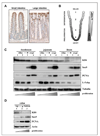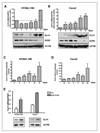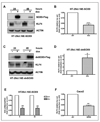KLF4 regulation in intestinal epithelial cell maturation
- PMID: 18977346
- PMCID: PMC2652355
- DOI: 10.1016/j.yexcr.2008.10.004
KLF4 regulation in intestinal epithelial cell maturation
Abstract
The Krüppel-like factor 4 (KLF4) transcription factor suppresses tumorigenesis in gastrointestinal epithelium. Thus, its expression is decreased in gastric and colon cancers. Moreover, KLF4 regulates both differentiation and growth that is likely fundamental to its tumor suppressor activity. We dissected the expression of Klf4 in the normal mouse intestinal epithelium along the crypt-villus and cephalo-caudal axes. Klf4 reached its highest level in differentiated cells of the villus, with levels in the duodenum>jejunum>ileum, in inverse relation to the representation of goblet cells in these regions, the lineage previously linked to KLF4. In parallel, in vitro studies using HT29cl.16E and Caco2 colon cancer cell lines clarified that KLF4 increased coincident with differentiation along both the goblet and absorptive cell lineages, respectively, and that KLF4 levels also increased during differentiation induced by the short chain fatty acid butyrate, independently of cell fate. Moreover, we determined that lower levels of KLF4 expression in the proliferative compartment of the intestinal epithelium are regulated by the transcription factors TCF4 and SOX9, an effector and a target, respectively, of beta-catenin/Tcf signaling, and independently of CDX2. Thus, reduced levels of KLF4 tumor suppressor activity in colon tumors may be driven by elevated beta-catenin/Tcf signaling.
Figures






Similar articles
-
Notch inhibits expression of the Krüppel-like factor 4 tumor suppressor in the intestinal epithelium.Mol Cancer Res. 2008 Dec;6(12):1920-7. doi: 10.1158/1541-7786.MCR-08-0224. Mol Cancer Res. 2008. PMID: 19074836 Free PMC article.
-
Krüppel-like factor 5 is important for maintenance of crypt architecture and barrier function in mouse intestine.Gastroenterology. 2011 Oct;141(4):1302-13, 1313.e1-6. doi: 10.1053/j.gastro.2011.06.086. Epub 2011 Jul 18. Gastroenterology. 2011. PMID: 21763241 Free PMC article.
-
Krüppel-like factor 4 is transactivated by butyrate in colon cancer cells.J Nutr. 2004 Apr;134(4):792-8. doi: 10.1093/jn/134.4.792. J Nutr. 2004. PMID: 15051827
-
The diverse functions of Krüppel-like factors 4 and 5 in epithelial biology and pathobiology.Bioessays. 2007 Jun;29(6):549-57. doi: 10.1002/bies.20581. Bioessays. 2007. PMID: 17508399 Free PMC article. Review.
-
From intestinal stem cells to inflammatory bowel diseases.World J Gastroenterol. 2011 Jul 21;17(27):3198-203. doi: 10.3748/wjg.v17.i27.3198. World J Gastroenterol. 2011. PMID: 21912468 Free PMC article. Review.
Cited by
-
Downregulated KLF4, induced by m6A modification, aggravates intestinal barrier dysfunction in inflammatory bowel disease.Cell Mol Life Sci. 2024 Nov 29;81(1):470. doi: 10.1007/s00018-024-05514-7. Cell Mol Life Sci. 2024. PMID: 39612002 Free PMC article.
-
KLF4 and SOX9 transcription factors antagonize β-catenin and inhibit TCF-activity in cancer cells.Biochim Biophys Acta. 2012 Oct;1823(10):1666-75. doi: 10.1016/j.bbamcr.2012.06.027. Epub 2012 Jul 2. Biochim Biophys Acta. 2012. PMID: 22766303 Free PMC article.
-
TGR5-HNF4α axis contributes to bile acid-induced gastric intestinal metaplasia markers expression.Cell Death Discov. 2020 Jul 6;6:56. doi: 10.1038/s41420-020-0290-3. eCollection 2020. Cell Death Discov. 2020. PMID: 32655894 Free PMC article.
-
KLF4 Plays an Essential Role in Corneal Epithelial Homeostasis by Promoting Epithelial Cell Fate and Suppressing Epithelial-Mesenchymal Transition.Invest Ophthalmol Vis Sci. 2017 May 1;58(5):2785-2795. doi: 10.1167/iovs.17-21826. Invest Ophthalmol Vis Sci. 2017. PMID: 28549095 Free PMC article.
-
Krüppel-like factor 4 (KLF4): What we currently know.Gene. 2017 May 5;611:27-37. doi: 10.1016/j.gene.2017.02.025. Epub 2017 Feb 22. Gene. 2017. PMID: 28237823 Free PMC article. Review.
References
-
- Suske G, Bruford E, Philipsen S. Mammalian SP/KLF transcription factors: bring in the family. Genomics. 2005;85:551–556. - PubMed
-
- Black AR, Black JD, Azizkhan-Clifford J. Sp1 and kruppel-like factor family of transcription factors in cell growth regulation and cancer. J Cell Physiol. 2001;188:143–160. - PubMed
-
- Garrett-Sinha LA, Eberspaecher H, Seldin MF, de Crombrugghe B. A gene for a novel zinc-finger protein expressed in differentiated epithelial cells and transiently in certain mesenchymal cells. J Biol Chem. 1996;271:31384–31390. - PubMed
Publication types
MeSH terms
Substances
Grants and funding
LinkOut - more resources
Full Text Sources
Other Literature Sources
Research Materials

